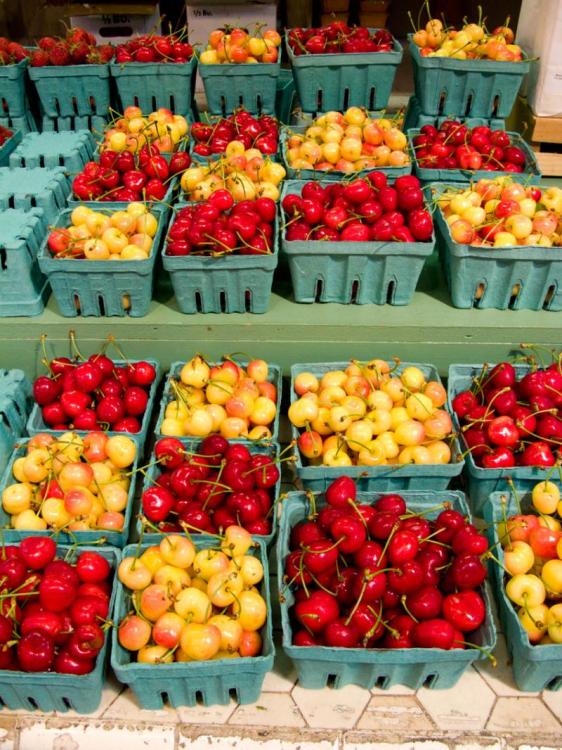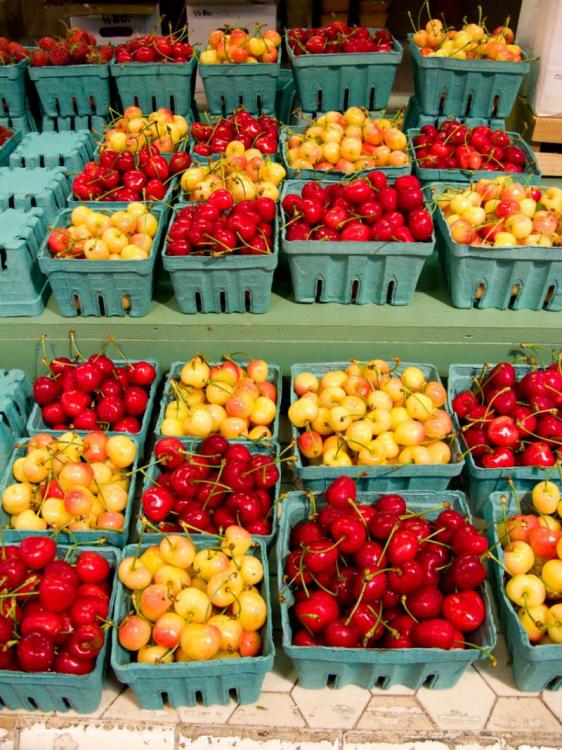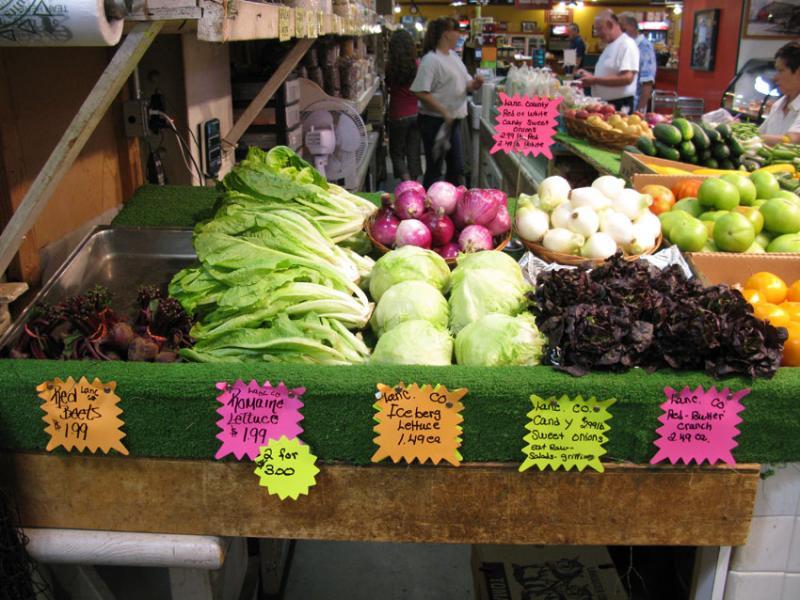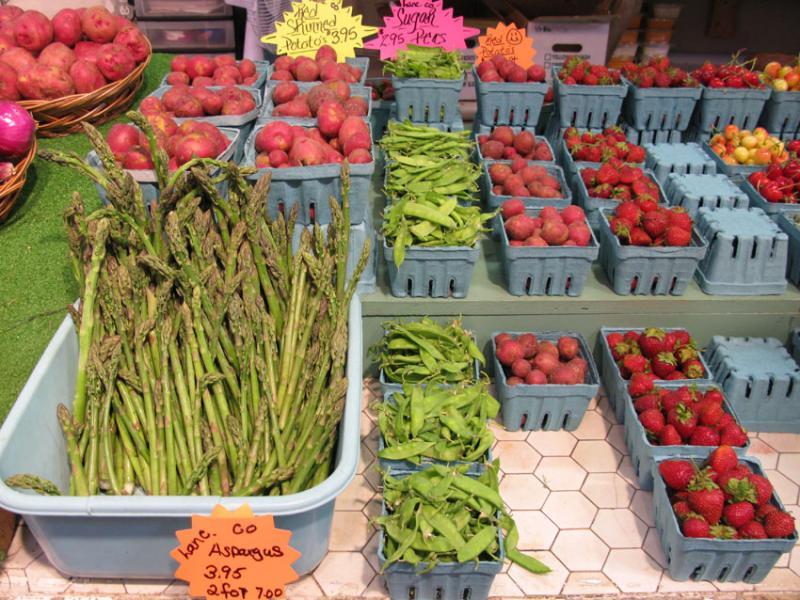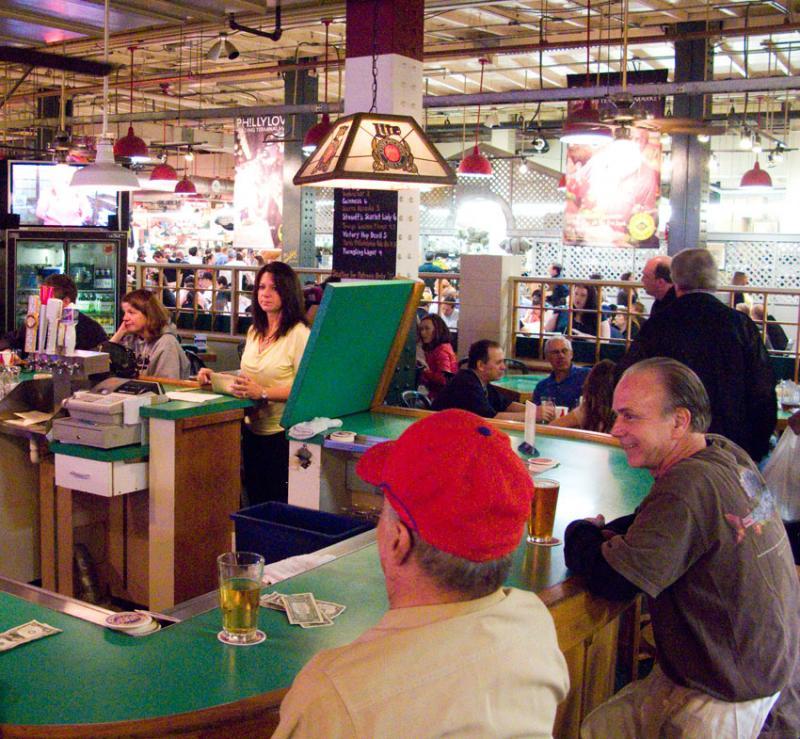-
Posts
3,022 -
Joined
-
Last visited
Content Type
Profiles
Forums
Store
Help Articles
Everything posted by rlibkind
-
Since Michael Klein in his The Insider blog today picked up and added to my earlier report on DiNic's forthcoming move to the vacated Ochs' location, here's the rest of the story (much of it also reported by Michael): The prime reason for all the musical chairs is Flying Monkey's lease for its center court spot. Originally the market wanted to move Flying Monkey to a new spot where coolers are now located (behind the wall displaying photos from pubic markets around the globe), but that wouldn't be on center court. Flying Monkey proprietor Elizabeth Halen would have been put at a locational handicap, so with the opening of the Ochs' spot, the musical chairs began. Getting the cupcakerie on center court will be accomplished by moving to the Spataro's spot once they move into DiNic's space. Flying Monkey will get some additional space from The Spice Terminal, which will extend a bit into the current seating area astride the existing Flying Monkey location. Paul Steinke hopes that the move of DiNic's will reduce congestion at the nexus of center court, which long lines waiting for roast pork sandwiches create a traffic jam from for one or two hours every lunch time. DiNic's additional seating may help as well. Beer Garden update Vinnie Iovine reports he and brother Jim received Philadelphia Historical Commission approval for their design on Friday. They still have some minor tweaks and approvals to obtain, but none that they see standing in the way. Once everything is in hand, expect a shut down of the Beer Garden after the Independence Day holiday for a month of renovations. When they reopen as Molly Molloy's, the entrance will be from center court and feature a gastro-pub menu from Bobby Fisher, who has long served as chef of the Iovines' catering operations.
-
Merchants will be playing musical chairs for the rest of the year as the Reading Terminal Market begins its major reconstruction project. One of the first moves will be by DiNic's to the center court stall vacated by Harry G. Ochs & Sons. Before it's over, expect at least three more center court merchants either to move to new spots along center court or alter their footprint, according to sources who did not wish to be identified because details are not yet settled for any except the DiNic's move, which still awaits signatures. All the subsequent moves, as currently proposed, rely upon the DiNic's relocation. As we reported in February (see original story here) the market will move Flying Monkey out of its current center court location to create a demonstration kitchen and meeting space along the Avenue D rear wall, and create additional retail space which will require adjustments to existing merchant footprints. Additional moves of merchants along Center Court could be firmed up and announced as early as next week. Alert shoppers may have noticed a sign at the now vacant Market Blooms spot on Avenue C, between Giunta's and Coastal Cave, announcing that L. Halteman's will shift its footprint to take over that space, since they will lose part of their existing footage to the Avenue D project. Preliminary plans call for Halteman's deli counter to front on Avenue C. Market Blooms continues to operate its Avenue A space along the 12th Street side of the market. Paul Steinke, the RTM's general manager, emphasized that the market will retain the existing ratios of purveyors to food court businesses, although the locations within the market are subject to change. Steinke said he is evaluating applications from a large number of potential vendors encompassing all four categories of merchants: Purveyors, Food Basket, Mercantile and Food Court. (For a more detailed description of those categories, see my article on RTM Lease Structure here.) The market's mission statement calls for it to provide a wide variety of produce, meat, fish, bakery and dairy products, and other raw and prepared food. Its Operating Policy Guidelines specify that in filling vacancies general preference be given to growers and purveyors of local and regional produce, and that businesses offering food intended primarily or exclusively for consumption within the market be limited to no more that the greater of one-third of the total businesses in the market, or one-third of the total leasable area of the Market. DiNic's move will make its operations much more efficient, since Ochs is a considerably larger space and also features a walk-in refrigerator, which will eliminate the need to haul meats from storage areas elsewhere in the market. They will also be able to double seating capacity. A probable addition to the menu will be meatballs.
-
Local cherries maede their debut today at the Reading Terminal Market in Philadelphia. They are dear, however, at $5.99/pound for sweet reds and $6.99 for Queen Annes. They were being sold by Kauffman's Lancaster County produce, operated by Benuel Kauffman. Although Ben raises some produce, most of what he sells is acquired from other Lancaster County growers. More photos and details can be found on the Pennsylvania Cooking board's Reading Terminal Market topic. Also available: local sweet peas, new potatoes, lettuces, onions, strawberries (end of season soon), cucumbers, green beans, asparagus, summer squash.
-
Local cherries made their seasonal debut today, but they didn't come cheaply. The first vendor to have them that I've seen is Kauffman's Lancaster County Produce at the Reading Terminal Market. In previous seasons, Ben Kauffman priced his berries by the pint or quart. At least for the start of the season, he's pricing them per pound. The red cherries today were $5.99, the Queen Anne variety $6.99. Since a pint weighs out at about three-quarters of a pound, the pint price for the reds works out to about $4.50, a buck more than last year's $3.50. Since this year's crop is expected to be decent, figure the price should come down as more vendors offer the first of the season's stone fruits. Last year, West Coast cherries sold for as little as 59-cents a pound at Iovine Brothers. Earlier this week I reported that Iovine's red bell peppers were unexpectedly cheaper than the frying peppers, $1.99 a pound vs. $2.49. Today the price of the latter came down $1.99. Meanwhile Vinnie Iovine was touting his Georgia peaches (he joked is staff mis-spelled the price card, as "Spothern" rather than "Southern" peaches. He says although rock hard, they are considerably sweeter than the California's he sent back to his wholesaler. Back at Ben Kauffman's he had a full complement of spring veggies today, including a number of different onions. Here are the photos:
-
I've been there and it's a small but well-done museum on the main street in downtown. They've got an amazing selection and some interesting displays and literature about mustard. A little touristy, as they also function as a shop, but certainly worth a look if you're in Mount Horeb. Note my item a few posts upthread. It's been in Middleton, not Mount Horeb, for a couple of years.
-
I was back in Madison in late April and got to try another dish at Cooper's Tavern, as I vowed after my visit last year. The Pork belly mac 'n cheese is a pig-lovers delight. Eat it!. As for that veal marrow -- the gent sitting next to me at the bar had one portion and when he knocked that off, ordered another. Not a bad idea. Also on this trip, I visited the National Mustard Museum, which moved a few years ago to Middleton, a suburb of Madison, from Mount Horeb. During my visit there was a celebration honoring the winners of the 2011 World Wide Mustard Competition and an Iron Mustard Chefs Competition (using the winning mustards). Cooper's Tavern Exec Chef Tim Larsen was one of the competitors, but you'll be surprised who won the cook-off. You can find a report, undoubtedly with more details than you need to know, on my blog here.
-
The National Mustard Museum moved a few years ago to Middleton, a suburb of Madison. I was there last month for a celebration honoring the winners of the 2011 World Wide Mustard Competition and the Iron Mustard Chefs Challenge, both fund-raisers for the non-profit museum. You can find a report, undoubtedly with more details than you need to know, on my blog here.
-
Writing in the The Ellsworth American and Mount Desert Islander, two jointly-owned newspapers serving Hancock County, Maine, Stephen Rappaport reports that the price for elvers (baby eels) hit $1,000 a pound this week. Known as "glass eels," the buyers ship them off to China and Taiwan where they are raised in ponds to market size, then shipped to Japan and other markets. There are about 2,200 to 2,2400 elvers to a pound. In Maine the elver season this year began March 22 and ends May 31. Just a decade ago the average price per pound was $24, though last year it was about $185. There's been a gold rush for elvers before in Maine: in 1995, 16,600 pounds were netted, while only 1,300 were nabbed the previous year. Speculation in Asia may account for the price. Here's a link to a recipe article in the Taipei Times.
-
Brassicas like cauliflower are an autumnal crop, so they should be in season on the far side of the earth about now
-
That lamb breast purchased from Livengood Thursday turned into a Saturday night pulled lamb fest. Because it was well-trimmed and much leaner than expected, the piece (a tad less than a pound) yielded three servings. Keep in mind the rib bones are not at all dense, so they don't make up much of the weight. With the oven set at a temperature 275 F they cooked directly in an open roasting pan (no need for a rack when there's so little fat) for two hours before I added salt and pepper and covered the pan with foil. (Some recipes would add chopped onion at this point, which is good idea, except this lamb was so lean the onions would have burned.) After about an hour and a half more they were removed from the oven and allowed to cool. While the lamb was in its last lap in the oven I made a Carolina style mustard-based barbecue sauce, figuring it would provide a nice counterpoint to the rich lamb which a tomato-based sauce would not. When the lamb cooled enough to handle I pulled it off the bone and shredded it with hand and fork, then tossed the warm sauce and lamb together. Served with cornbread and a beer (Victory's high octane 9.5 percent triple, Golden Monkey) it made a tasty dinner. All that was missing was the slaw.
-
Additional farmers' markets begin seasonal operation this week, beginning Tuesday in Mt. Airy. That market, under the auspices of Farm to City, runs from 3 to 7 p.m. in the William Allen plaza of Lutheran Theological Seminary, on the 7200 block of Germantown Avenue. On Wednesday, the Food Trust opens Schuylkill River Park (25th & Spruce, 3-7 p.m.) and Broad & South (2-7 p.m.) and Farm to City debuts at East Passyunk at 11th and Tasker (3-7 p.m.), Oakmont in Havertown (Oakmont Municipal Parking Lot, Darby Road just west of Eagle Road, 3-7 p.m.). Earlier this month, Farm to City opened University Square Farmers' Market (36th and Walnut, 10 a.m. - 3 p.m.) This full schedules can be found at these links: Food Trust markets Farm To City markets The Food Trust page includes a cool Google map locator; click on each market mark for location, days and hours.
-
Radishes? Check. Asparagus? Absolutely. Rhubarb? Of course. Strawberries? Pushing it. Zucchini? Get outta here! Still, in making its 2011 Headhouse Farmers' Market debut Sunday, Blooming Glen Farm featured little summer squashes, a.k.a. zucchini, at $3 a pound. I think I'll wait until my neighbors are giving them away in August. In the meantime, one can be perfectly happy with the profusion of asparagus, early lettuces and other greens of all sorts, the ravishingly red radishes and fresh, green varieties of allium -- green garlics, green onions, chives -- which could be found not only at Headhouse Sunday, but at Rittenhouse and Clark Park yesterday, Fairmount Thursday and all the produce stalls at the Reading Terminal Market. Another sign of the season being pushed just a tad (besides the grown-under-plastic strawberries offered by A.T. Buzby at Headhouse) were snow peas Noelle Margerum displayed at Clark Park. She returned from a brief vacation to find them ready to pick, so to market they came. Tom Culton's radishes were a tad larger than last week, of course, but they looked just as fresh and the greens just as tender. He and co-farmer Matt Yoder also had what they labelled as "framps," in actuality a wild garlic. Asparagus, salad greens, rhubarb and parsnips helped fill out the stall. Tom's foie gras production has started, though his limited quanity was sold out yesterday, with most of his output marked for restaurant customers, I presume. He hopes to have some at tomorrow evening's "for the trade" Local Growers/Local Buyers event at the RTM sponsored by Fair Food. Queens Farm was back with its pristine and colorful mushrooms, as well as greens, spring green onions and garlic, and flowers. Blooming Glen's offerings, besides the summer squashes, included cilantro, parsley, tatso, green onion, thyme, oregano, garlic chives, bok choi and various lettuces. Of you've got your own garden in need of feeding, you could have stopped by a stall that's new this year, Bennett Compost. Although not all available spaces at Headhouse were filed today, it's getting close. Vendors at today's Headhouse market included: Root Mass Farm, Savoie Organic Farm, Rics Bread, Garces Trading Company, Hurley's Nursery, Honest Tom's Tacos, Renaissance, Sausage, Made in Shade Lemonade, Three Springs Fruit Farm, Patches of Star Goat Dairy, Hillacres Pride Farm, Busy Bee Farm, John + Kira's, Happy Cat Organics, Griggstown Quail & Farm Market, Market Day Canele, Philadelphia Fair Trade Coffee, Mountain View Poultry, Weaver's Way, Talula's Table, Longview Flowers, Birchrun Hills Farm and, Young's Garden. Among the missing was Wild Flour Bakery. So, how to use some of those veggies? Pasta is always a no-brainer, and it shows up the vivacity of early produce wonderfully. Earlier this week I used Culton's asparagus in penne. While the pasta water came to a boil I started warming up maybe a cup of homemade broth (I used beef, but no reason not to use chicken or veggie), to which I added cut up asparagus and thyme (fresh would be best, but I only had dried) when the pasta was nearly done. Drain the penne or other cut pasta when done, swirl as large a knob as butter as you can in good conscience consume into the asparagus and broth, and toss everything together with an obscene amount of freshly grated parmesan and maybe a grind or two of black pepper. It's an infinitely variable recipe. Had I felt like doing a bit more prep work, carrot juliennes would have been a welcome addition, as would some of Noelle Margerum's snow peas. Just add the veggies to the broth in order as required for timing purposes. Voila! Pasta Primavera. You could also sauté veggies rather than simmer. That's what Mark Bittman does in his New York Times Magazine recipes today. Radishes at Blooming Glen today:
-
A correction to my earlier reference, with erroneously suggested the Ochs family adopted Nick's father. They didn't. And it was Nick's grandfather who originally joined the business. The paragraph should have read: It was wrenching for Steinke and the market to lose the Ochs business, which moved there only 14 years after the market opened its doors in 1892. Nick's grandfather joined the business in the first half of the century and adopted the Ochs name when he took it over. Indeed, his son Harry was better known as Harry Ochs than as Harry Finocchio. When the market's future was threatened by the proposed construction of the Pennsylvania Convention Center, it was Harry Finocchio who was a key player in preserving the market and pressuring the center to renovate the then-dilapidated structure. Today, the block of Filbert Street astride the market is known as Harry Ochs Way.
-
At The Beer Garden, Jack Morgan, proprietor of Downtown Cheese, far right, enjoys a brewski. As anticipated Jimmy and Vinnie Iovine took over ownership of the Beer Garden at the Reading Terminal Market earlier this week, and they quickly made changes, though more will come in the months ahead. The most visible change is the removal of the latticework that isolated the pub from the rest of the market. Now, with only a half wall around three quarters of its borders, The Beer Garden opens up invitingly to market shoppers. In addition to a general quick cleanup of the space, the Iovines also introduced craft brews, both on tap and in bottles. The taps now feature Guinness and Stoudt's Scarlet Lady, along with Yuengling and a couple mass market brews. For the moment, they are promoting it as "The Beer Garden (by iovine brothers)", but when major reconstruction takes place, including installation of a kitchen, it will be a gastropub called "Molly Molloy's," in honor of the brother's Irish mother.
-
The 1940s photo mural of Harry Ochs and his father, which adorned the wall alongside the butcher stall, was among the items take by Nick "Ochs" Finocchio when he decamped in the dead of night May 2 from the Reading Terminal Market. It now awaits hanging at Nick's new digs, the Main Street Market in Manayunk. The large historic print, like others scattered throughout the market, was made in the 1980s under the auspices of David K. O'Neil, general manager of the market when it was still owned by The Reading Company. So when Nick took the physical print, he was taking something that didn't belong to him. At the same time, the original photo probably came from the Ochs family, so if that's true, when Nick told me "It's my photo" he would be correct, in the sense that it's his intellectual property. Of course, when the Ochses permitted the market to reproduce the photo, they were essentially granting permission to the market to use the photograph in public. And while I imagine a lawyer would say the family has the right to prohibit the market from publicly displaying the photo, they don't have the right to walk off with a print that the market paid to make and mount. All these legal niceties aside, it's too bad that the only physical remnant of the Ochs business left behind is the lettering signage on the meat hook posts. It's almost as sad as the fact that Nick and market management couldn't find a way to keep the business going within the historic market.
-
Although the Livengoods, who now limit their venues to outdoor markets, no longer sell lilac blossoms -- because the petals would be denuded exposed to the wind -- Dwain Livengood did have Lily of the Valley plants. I picked up a couple of bunches, with their altogether different but just as pleasureable scent, at the Fairmount Farmers' Market yesterday. Last week Dwain told me he's now selling lamb raised by a neighbor, and plans to run his own flock. Among the cuts Dwain had yesterday was lamb breast, either in whole or riblet form; I bought the former and plan to indirectly grill it this weekend. Although I've enjoyed chevre many times in the past, I had never tasted its source milk before yesterday. Thanks to Sunny Side Goat Dairy, operated by Joseph and Joanna Mack, I sampled some raw goat milk, and found it fresh and delightful with no "goaty" flavor at all (nor should it have any). In addition to various chevres and the milk, the Macks also sell goat meat (lovely in curries) and yogurt. That's Joseph in the photo below.
-
If it's for ravioli, maybe you can get pumpkin/squash (I forget the Italian name). Great combo with sage brown butter, though I think of it more as an autumnal dish.
-
Calvados starts out as an Eau de vie, a clear, colorless liquid distillate made from hard apple cider. It is then aged in an oak cask for at least two years. It's no longer an eau de vie at that point, but Calvados. Yes, it's made from what is essentially an eau de vie, but that's not what it is. To call Calvados an eau de vie is like saying Scotch whisky is really a malt beverage: a truism.
-
I like to chiffonade most of the sage, with the exception of a couple of leaves which I leave whole for each plate.
-
Well, good luck with it. Let us know how it turns out.
-
Clear Creek in Oregon makes a cassis liquer, but not an eau de vie. It's made from Oregon black currants macerated in one of the distillery's clear fruit brandies. (They make seven varities of eau de vie, but not one from currants.) If you want to duplicate what you had at Au Pied Cochon, I don't think you'd want to use an eau de vie, since Calvados is anything but that. I'm pessimistic in how an eau de vie would work in the manner Au Pied Cochon used the calvados, which is more akin to a whiskey or aged brandy than an eau de vie, which is clear, unaged, and much hotter in taste due to its higher alcohol content (90 proof vs. about 80-82 proof for calvados and other aged brandies).
-
I was out of town when Headhouse opened the first Sunday in May, but made it there this past Sunday. The big surprise was seeing strawberries at A.T. Buzby, $6/quart iirc. They were grown under plastic, so I'm going to what a couple weeks more before induling. Tom Culton was there in spades, with plenty of asparagus spears (pick the individually, rather than pre-packaged in bunches) I picked up a small handful which I used with pasta (cooked in homemade beef broth out of the freezer, then finished with a knob of butter, tossed with penne and doused in immoderate quantities of parmesan reggiano. Tom had gorgeous tiny radishes, also, about $4/pound iirc, including the tender, spicy leaves, which I add to salads and may also be cooked as any other green. Greens and roots were exceptionally good. I couldn't resist a bunch of lilacs for SWMBO from Queen Farm, $5 for a small bouquet, but the aroma was worth every penny. The previous Thursday I got to the first Fairmount market of the season (Fairmount and 22nd, opposite the Eastern States Penitentiary historic site) where Earl Livengood had ramps, for only two-thirds the price Iovines was charging, and Sam Stolfus's offerings included bibb and leaf lettuce (hoophouse). I also picked up veal liver from Birchrun, the cheese-maker, at just under $10/pound. Expensive, but the quality can't be beat.
-
There's a big difference tween farmers' markets and public markets. Soulard is a public market. Farmers' markets should be what they sound like: a market which only operates a day or two a week when farmers can leave the fields and bring their output to town. While public markets can frequently include farmers, they are six or serven-day a week operation in which purveyors sell a variety of food related products -- not just produce and meats, but dairy, baked goods, fish, coffees and teas, etc., usually acquired from wholesalers though sometimes directly from producers. Seattle's Pike Place and Philadelphia's Reading Terminal markets are public markets, even if they also include, at least a few days a week, local farmers. If we were to include public markets in this survey (which I don't think we should, since there are so few true public markets in this country today, and most of these are more into serving lunches to office workers than food for the home cook) they could beat the pants off supermarkets in both quality and price. At the market I know best, the Reading Terminal, the butcher I most frequently use doesn't sell USDA prime (as is the case among most farmers' markets meat sellers), but he buys sides of beef individually, so his USDA Choice is almost as good as prime, though he only does limited dry aging. His prices are the same as a supermarket's everyday prices, and quality superior. The two major produce vendors at the Reading Terminal Market both outdo supermarkets in price and quality. One of them is exceedingly large and buys more produce than most individual supermarkets do (though clearly not as much as a regional group or chain). This results in prices that regularly are lower than a supermarket's and quality that is significantly better. That vendor even has his own direct relationships with area farmers, so you get the benefit of purchasing seasonal, local produce, fresh from the farm, at excellent prices. He even beats supermarket prices (by a long shot) on "imported" produce like California and Florida oranges, Mexican, Chilean stone fruit (in our winter), etc. Though I only occasionally report supermarket price, I've been noting prices at both local farmers' markets and the RTM for the past five years at my blog: robertsmarketreport.blogspot.com or bookschlepper.com/marketblog I usually post excerpts at two eGullet subjects: 2011 Farmers Markets Reading Terminal Market
-
All that sand may account for the price dif. The $69.99 price at Iovine's in the RTM bought me nice large, fresh (not at all dried out) samples, all very clean except for the one ugly bug I found. That's about the same price Earl Livengood charges at farmers' markets for the morels collected by his pal Sam Consylman. Nonetheless, maybe I'll take a trip north to your market this Sunday! A little work to clean them is not a bad thing at that price saving!
-
Like Sparrowgrass, I always split morels lengthwise, and brush them well, examining the folds as well as the interior. I found a particularly hard-shelled insect in my last batch, with devilish looking horns. I don't wash, just trim the base if necessary. Although I think the fried morels are undoubtedly high on the deliciousness scale, I think they're too dear (just under $70/pound in my neighborhood, since I don't collect them myself) to put to breading. A quick sauté served with similiarly treated spring veggies (asparagus, fiddleheads, ramps, whatever), served around a savory lightly cheesey custard and adorned with beurre blanc. Can't beat it.



